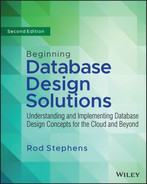PART 2
Database Design Process and Techniques
- Chapter 4: Understanding User Needs
- Chapter 5: Translating User Needs into Data Models
- Chapter 6: Extracting Business Rules
- Chapter 7: Normalizing Data
- Chapter 8: Designing Databases to Support Software
- Chapter 9: Using Common Design Patterns
- Chapter 10: Avoiding Common Design Pitfalls
The chapters in this part of the book contain the bulk of the information about the database design process. They discuss the major steps in database design, starting from the beginning of a project and working through various design and refinement stages to provide a fully functional database.
Chapter 4 explains how you can learn about the customers’ needs. If you don’t understand your customers’ needs, how can you possibly build a database that satisfies them? This chapter also explains how to ensure that the customers agree with you on what the database should do so that everyone is happy with the final result.
Chapter 5 shows how to translate the customer needs (defined in Chapter 4) into several different kinds of data models. These data models allow you to formally represent the database’s needs. They let you study the data and rearrange the pieces in order to build toward a flexible design.
Chapter 6 explains how to identify business rules. It tells how to modify the data models that you developed in Chapter 5 to make it easier to manage business rules, which may change relatively frequently.
Chapter 7 describes one of the best-known steps in designing a relational database: normalization. A properly normalized database is robust and more resistant to certain kinds of potential data errors than a non-normalized database.
Chapter 8 discusses some database design issues that affect the database’s use and maintenance in a larger application. The techniques described in this chapter make it easier for application developers to build an effective, flexible user interface for the database.
Chapter 9 describes some patterns that occur in many applications. It then explains solutions that you can use to make handling those patterns simple.
Chapter 10 describes some pitfalls that often hinder database designers. Avoiding these problems can make the database design process easy, fast, and effective.
After you finish working through these chapters, you will have a good understanding of database design. You will know how to decide what data belongs in a database, how to build data models, and how to convert those models into powerful, flexible database designs.
